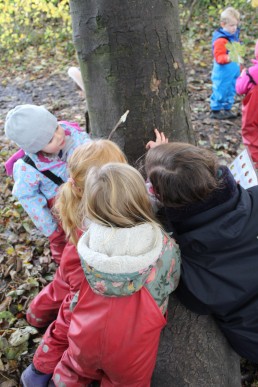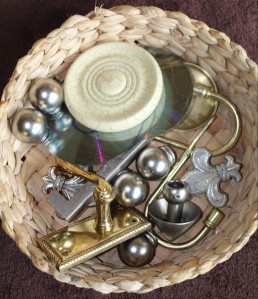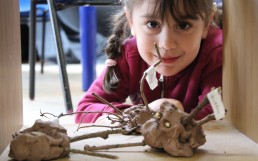The Benefits of Forest School
At Inspirations we value greatly our outdoor environments which are extensive and include the use of our local Horsforth woodland at Hunger Hills. Our passion for outdoor learning and forest school comes from a deep understanding and appreciation for the ethos. The pedagogy was developed in Sweden in the 1950’s and the approach focuses on the natural environment being utilised, not only as an area where children can blow off excess energy but more importantly where children are given the opportunity to immerse themselves in nature.

http://simonr30.sg-host.com/our-settings/forsest-school/
Forest school children develop an appreciation and deep seated love of nature and are able to explore and learn from all that the environment has to offer, at a pace that suits them.
'Lead their own Learning'
The forest school ethos allows for each individual child to lead their own learning journey. They find their own pace, interests and methods of learning and attainment that best suit them. There is no pressure, no preconceived results, no adults determining a beginning or end to their project or interest.
Adults of course play a vital role one which is supportive and patient, they build strong positive relationships which children know they can trust and count on. The Adults help children take managed risks encouraging children to consider, they ask questions and encourage with a hands-on approach which helps supports critical thinking.


Resilience and Determination
Forest school children are shown to be ahead of their peers by the time they start school at the age of five. They show confidence, are very willing to ‘have a go’ and not be deterred by failed attempts. They are resilient and eager to keep trying until they find a positive solution to a problem. It is shows they are effective problem solvers who work well within a team, exhibiting high levels of motivation and concentration to any task facing them.
The forest learning environment also creates strong communicators and gives children a deep level of understanding about the word around them. They are socially advanced, understanding feelings and consequences of their behaviour and are more likely to think before they act. Naturally children who spend time in wide open spaces where the floor is uneven, who have trees to climb and weather to navigate are more confident in their own physical abilities. They are more prone to want to be outdoors as adults and as a result are more healthier, happier individuals.


There are several studies on the benefits of forest school and outdoor learning philosophy. These studies are becoming more prevalent as the ethos has slowly become more popular. Below are a few links to the most recent studies showing the benefits mentioned in our blog above.
https://www.forestschoolassociation.org/new-research-a-longitudinal-study-on-forest-school/
- Nicola

Loose Parts
Why do we use loose parts?
Loose parts are a significant segment of our ethos at Inspirations Nurseries. Before moving away from conventional toys, we did a lot of research into the benefits of using loose parts. Several education pedagogies use loose parts. Reggio Emilia and loose parts complement each other well; we use both at Inspirations. Both philosophies support open ended play using natural resources, imagination, and creativity. When children are given opportunities to engage in free play with little adult direction, they are able to explore freely with creativity and expression, because there are no limitations or expectations.

What are Loose Parts?
Loose parts are open ended materials that can be moved around, designed, and redesigned. They create opportunities to use our imaginations and discover new ideas. Conventional toys are fixed for the one purpose they were made for, whereas loose parts are open ended and can be used for a variety of things. A plastic car can only be a car. A stick could be a magic wand or a person or you could use a number of them to make a house… the possibilities are endless. Ask any parent how long their children will play with the cardboard box a toy comes in on their birthdays. Loose parts can be found anywhere. How many of us remember going to the beach and collecting shells and stones and making patterns with them? You can find loose parts in the house, in the garden or on a walk. Loose parts include both manufactured and natural resources. These can include stones, pinecones, rings, balls, blocks, boxes, leaves and even nuts and bolts.


Endless Possibilities
For outdoor play, we provide a variety of large loose parts such as tyres of different sizes, milk crates, planks of wood, cable reels etc. In our baby rooms, we use a variety of loose parts to support schemas; we use things like curtain rings to hang on mug trees, balls to post through holes, tyres to encourage rolling. Toddlers can then use slightly smaller loose parts such as pebbles to create patterns and smaller wood slices for counting. Preschool are able to use more intricate loose parts such as beads, small tiles and items they find on forest school.
The founder of the Reggio Emilia Philosophy said...
“Children need the freedom to appreciate the infinite resources of their hands, their eyes and their ears, the resources of forms, materials, sounds and colours”.
-Kayleigh
See loose parts in action in our Pre-School room here- https://youtu.be/Nngfh6Uj-yw
All photos from Inspirations Nursery
Walk of Art

Join us on Saturday 7th July for our opening day with live music from the amazing Biscuit Head and the Biscuit Badgers at 2.30pm.
Expect a clay workshop, a needle felted display, food and drink, campfire with marshmallow toasting and a freebie for the first 100 families to come.
Join us in the sunshine for a day of art and music.




